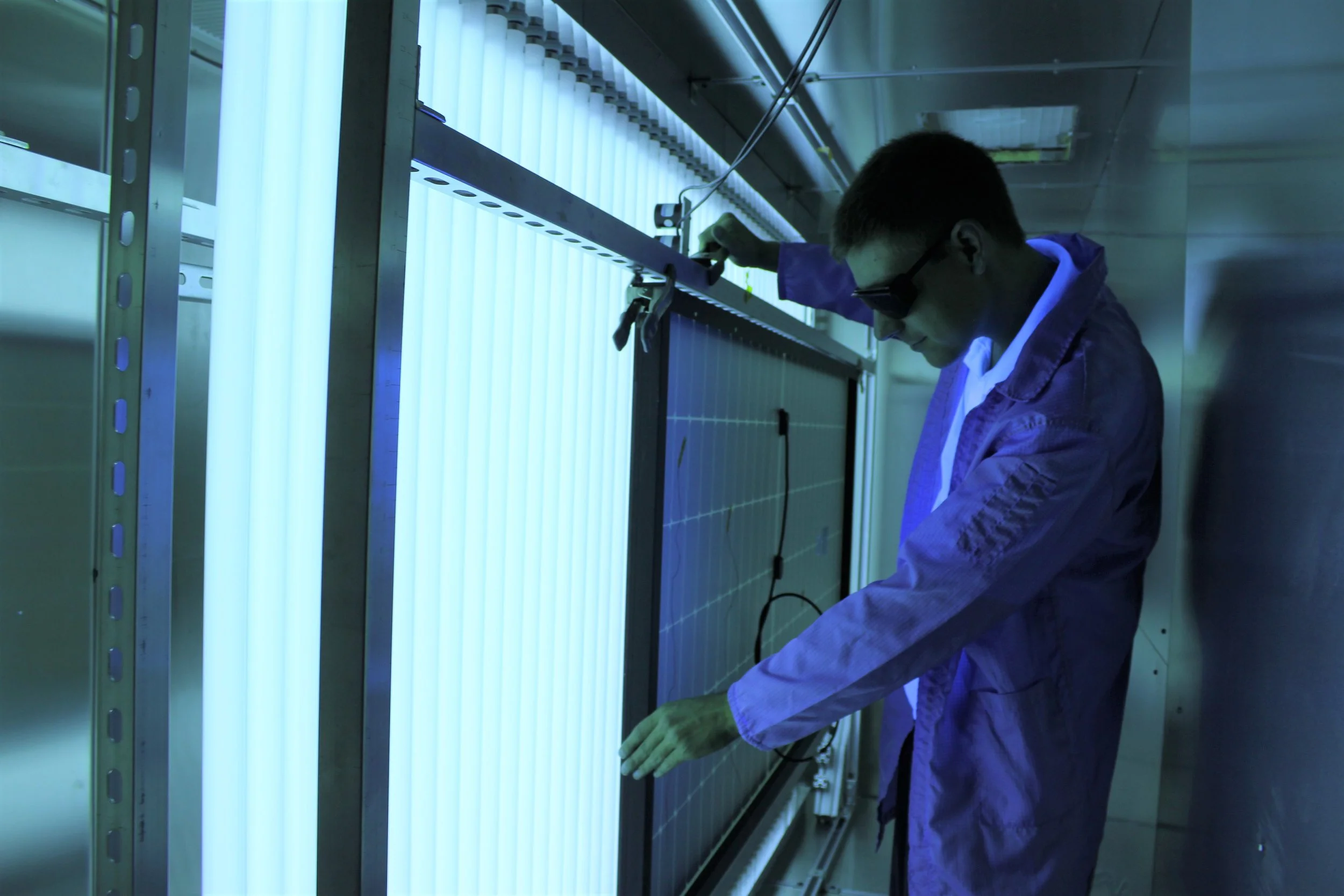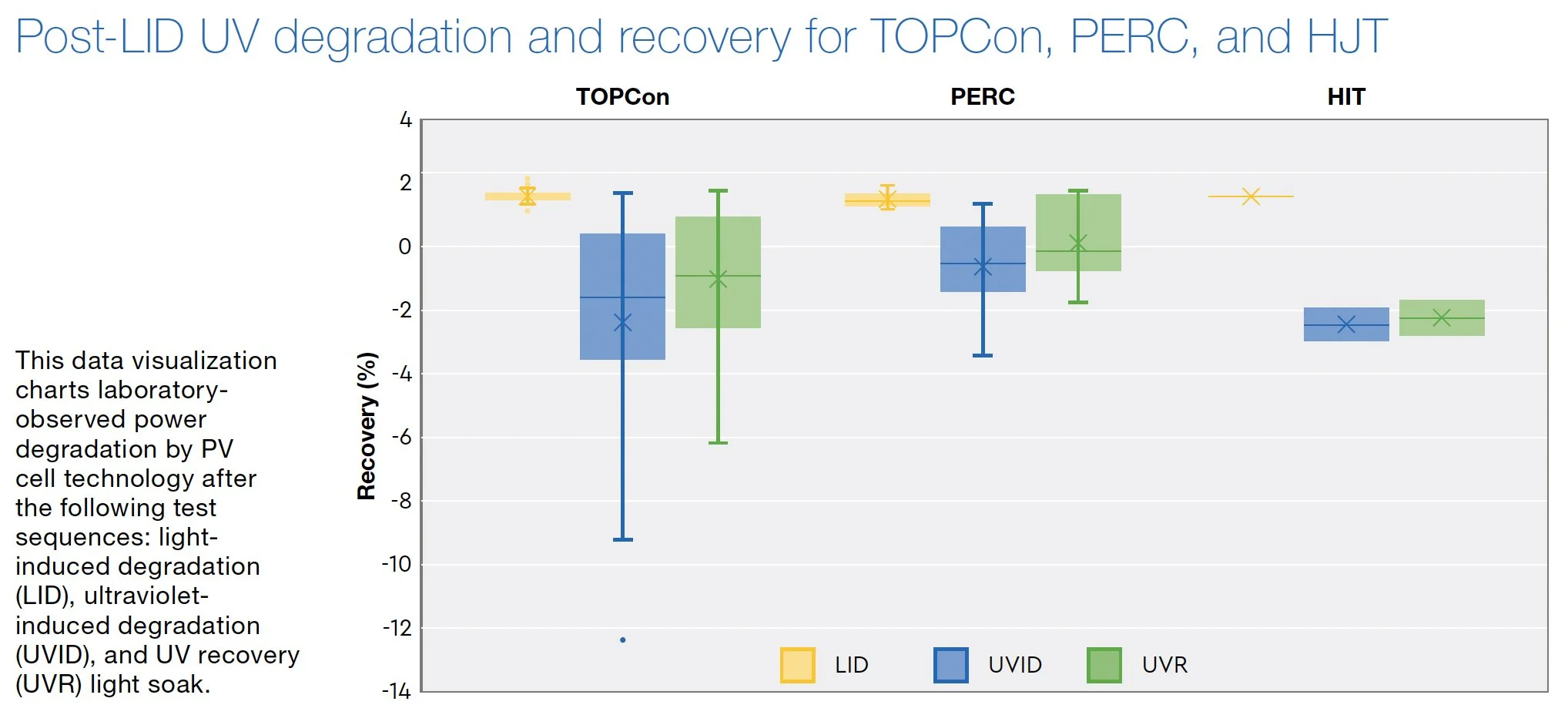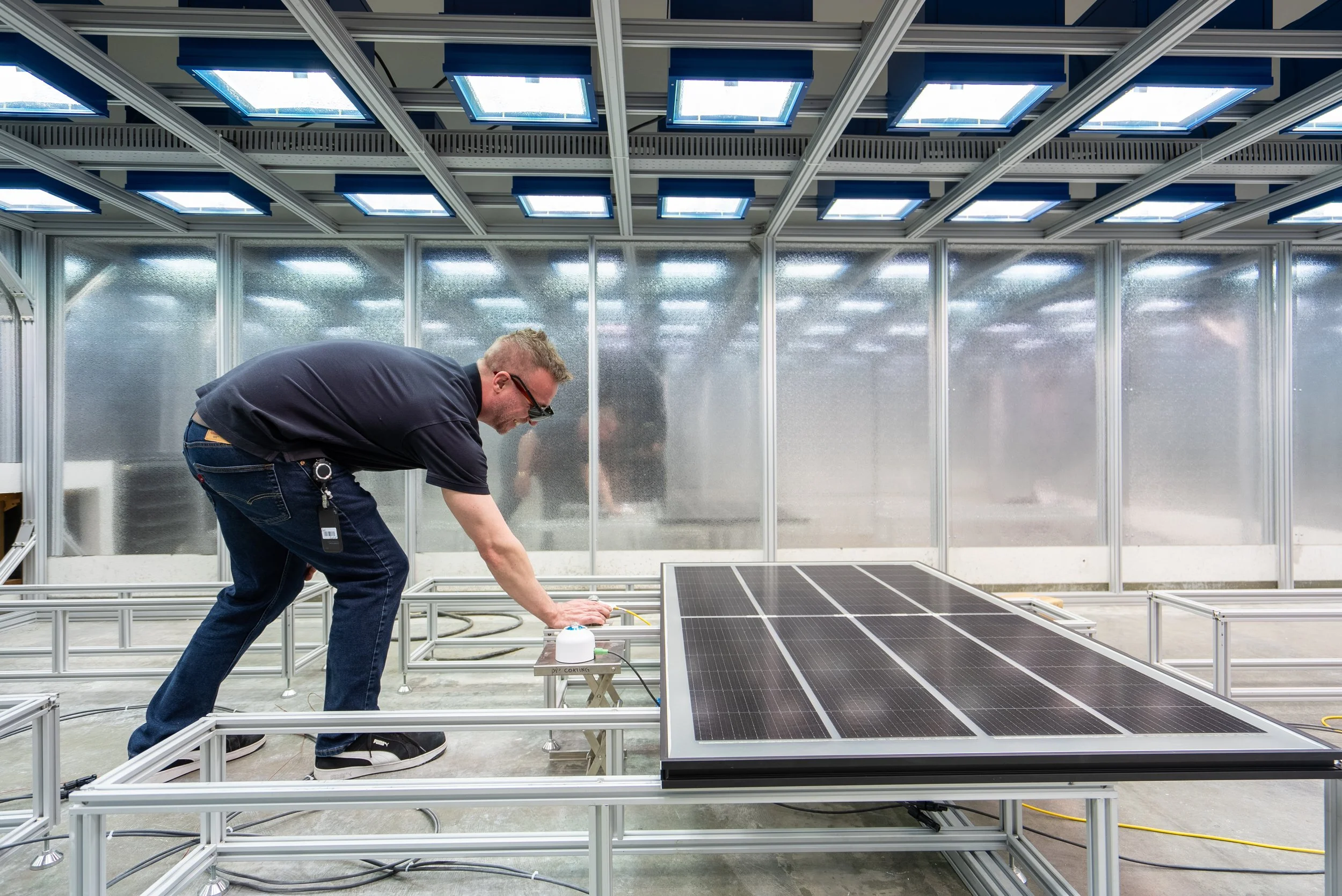Shedding Light on Ultraviolet-Induced Degradation
Recent testing to better understand power degradation during highly accelerated UV exposure indicates that laboratory-observed UVID is real, partially reversible, and—perhaps most importantly—entirely preventable.
In the 2024 PV Module Index Report, RETC flagged UV-induced degradation (UVID) as a potential field reliability issue for some newer high-efficiency PV cell technologies—most notably, n-type tunnel oxide passivated contact (n-TOPCon) devices. Specifically, we not only noted that roughly 40% of UVID test samples degraded by ≥5% but also observed double-digit degradation rates in some mass-produced PV modules.
Since market analysts predict that TOPCon devices could account for 80% of total solar cell shipments in 2025, it is imperative that the technical due diligence community understand UVID causes and effects, especially the extent to which laboratory observations correlate with in-field degradation. With this in mind, RETC has embarked on a series of experiments designed to help identify, characterize, and eradicate UVID risk in commercial PV products. Here, we present preliminary results of these ongoing and evolving investigations.
An encapsulated history of UVID
The solar industry has long managed the harmful effects of UV radiation on fielded PV modules. Industry veterans are undoubtedly familiar with visible module packaging problems resulting from UV exposure, such as encapsulant discoloration, internal delamination, or polymeric backsheet cracking. Module manufacturers and encapsulant suppliers have largely eradicated the UV degradation problems that once contributed to teething issues, such as ethylene vinyl acetate (EVA) browning, in legacy PV modules. UV light can also contribute to the formation of acetic acid on the encapsulant, which can degrade electrical performance by corroding metalized contacts.
Additionally, UV exposure can damage surface passivation and antireflective coating dielectric layers, causing a degradation in solar cell performance. Though the root causes of these types of UVID appear to vary according to cell type and passivation stack, testing laboratories, researchers, and material scientists all around the world have noted that modern solar cell technologies frequently exhibit comparatively high degradation rates when subjected to accelerated UV exposure. Whereas legacy aluminum back surface field (Al-BSF) PV cells consistently exhibited excellent UV stability, laboratory testing generally indicates that n-type TOPCon PV cells are the commercial technology most vulnerable to UVID.
To test the potential for UV degradation, RETC worked with experts in the technical due diligence community to develop a rigorous beyond-certification UVID testing sequence. As early as 2022, we reported that newer PV cell technologies appeared susceptible to UVID. Other testing laboratories around the world have reported similar results, warning of larger than expected efficiency and voltage losses.
Lessons from the UVID test program
Laboratory-reported levels of UVID susceptibility not only merit industrywide discussion and dialogue but also demand immediate and collective action to ensure that UVID does not become a major reliability issue in fielded PV assets and portfolios. With this in mind, in late 2024, RETC began inviting manufacturers to participate in a series of experiments designed to answer common questions about UV degradation modes and test results. Though simulated long-term exposure testing is still ongoing, here are some preliminary observations about UVID in today’s high-efficiency PV technologies based on data collected as part of our dedicated test program.
UVID is not unique to TOPCon devices. As shown in the graph above, three common high-efficiency solar technologies—namely, TOPCon, passivated emitter rear contact (PERC), and silicon heterojunction (HJT)—are all potentially susceptible to high (>2%) UVID rates after 110-hour UV exposure. In our sample set, the median UVID rate for PERC devices was approximately 2%, as compared to nearly 4% for HJT and TOPCon. We observed the highest degradation rates in TOPCon devices, recording >12% degradation in outlier cases and a cluster of results in the 5%–10% range.
Light soaking reverses some UVID effects. Performance recovers in virtually all test samples after exposure to a full-spectrum light source for 1 to 2 hours. While UV recovery is most significant in TOPCon devices, it is also evident in PERC and HJT ones. Full-spectrum light soaking never recovers the full effects of UVID. Given that UV recovery in the laboratory is always partial, some UV damage could be permanent.
UVID is preventable in TOPCon devices. Even before the UV recovery stage, some TOPCon test samples effectively register 0% degradation during 110 kWh UV exposure, which is roughly equivalent to 1 years’ worth of in-field exposure on a single-axis tracker. Even after they are subjected to multiple cycles of UV exposure, some bills of materials do not experience high degradation. In other words, some manufacturers have already succeeded in designing and manufacturing UVID-resistant TOPCon modules.
Manufacturers can solve UVID problems. The first step in solving a problem with UVID is recognizing that one exists in the first place. RETC has seen this firsthand in its work supporting manufacturers’ iterative product design and continuous improvement efforts. After our beyond-qualification testing identified high UVID in a particular test sample, one of our customers decided to try modifying the bill of materials by adding a UV-blocker that shifts UV wavelengths to the blue region. When RETC tested the subsequent product samples, we were happy to report that the bill of material alteration had eliminated the UVID problem. Additional testing is required to assess the overall reliability of this design approach in terms of prolonged exposure to heat, humidity, and thermal cycling.
UVID in real-world applications
Though testing laboratories, material scientists, and researchers have thoroughly documented high UV degradation rates in newer high-efficiency PV cell technologies, it remains unclear whether a correlation exists between these laboratory observations and real-world degradation modes. In an outdoor environment, PV modules are not subject to UV irradiance only but rather to full-spectrum light, which can reverse UVID and a variety of metastability effects.
If full-spectrum light exposure ameliorates or prevents UV damage in advanced PV modules, we may one day learn that UVID is a laboratory artifact that has little to no effect in fielded projects. Given the current scale of field deployments, however, we recommend that project stakeholders err on the side of caution. After all, developers routinely report perceived instances of solar asset underperformance under real-world conditions of use. If a correlation does exist between laboratory-observed UVID and real-world production losses, it is imperative that we solve the problem as soon as possible.
Record solar capacity additions are a rare beacon of hope on the troubled seas of climate crisis coverage. In 2024, solar markets around the world added approximately 600 GW of new PV power generation capacity, resulting in a cumulative global capacity of over 2.2 TW. These newly commissioned PV power systems accounted for more than three-quarters of the renewable energy capacity installed globally last year.
Some climate scientists are skeptical that it remains possible to keep global warming under the 1.5°C target enshrined in the 2015 Paris Agreement. However, most agree that collective efforts to avert the most severe and potentially irreversible human-caused climate impacts cannot succeed without the continued massive expansion of solar generation capacity. In other words, today’s solar developments and deployments are truly the critical power generation assets required for a worthwhile future.
Knowledge is power!
This article originally appeared in the 2025 edition of RETC’s annual PV module technology report.




